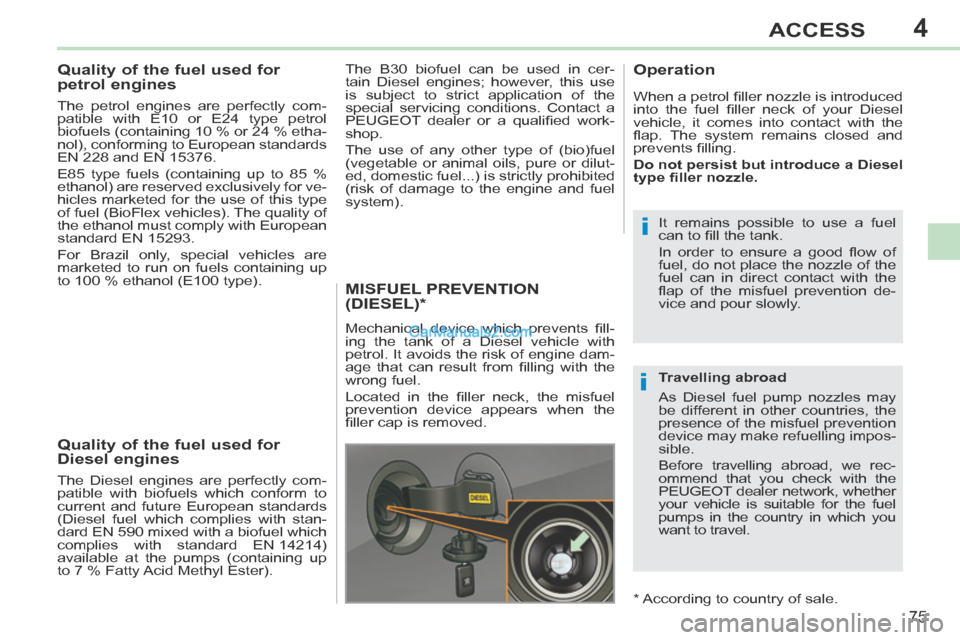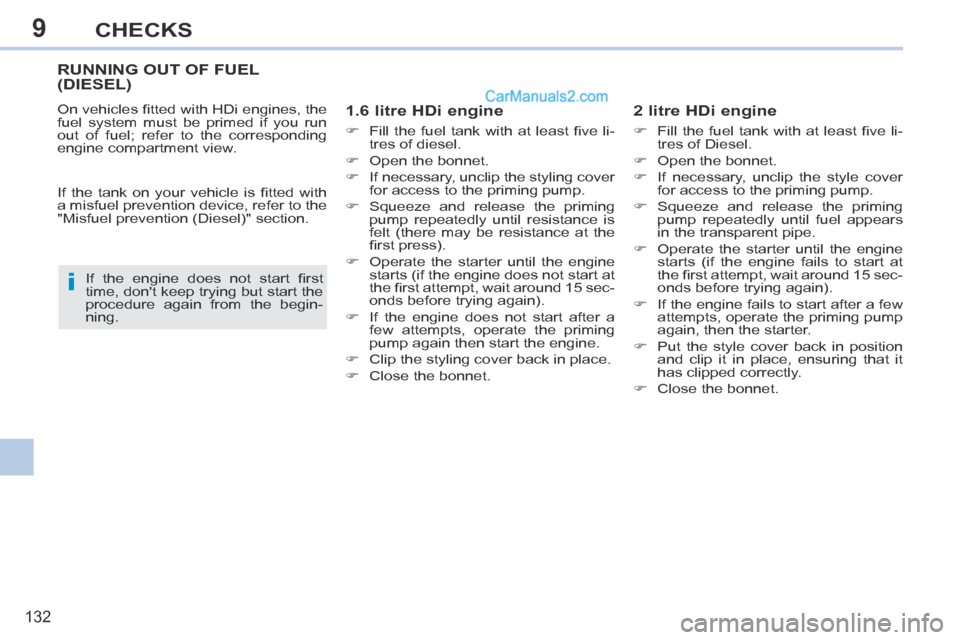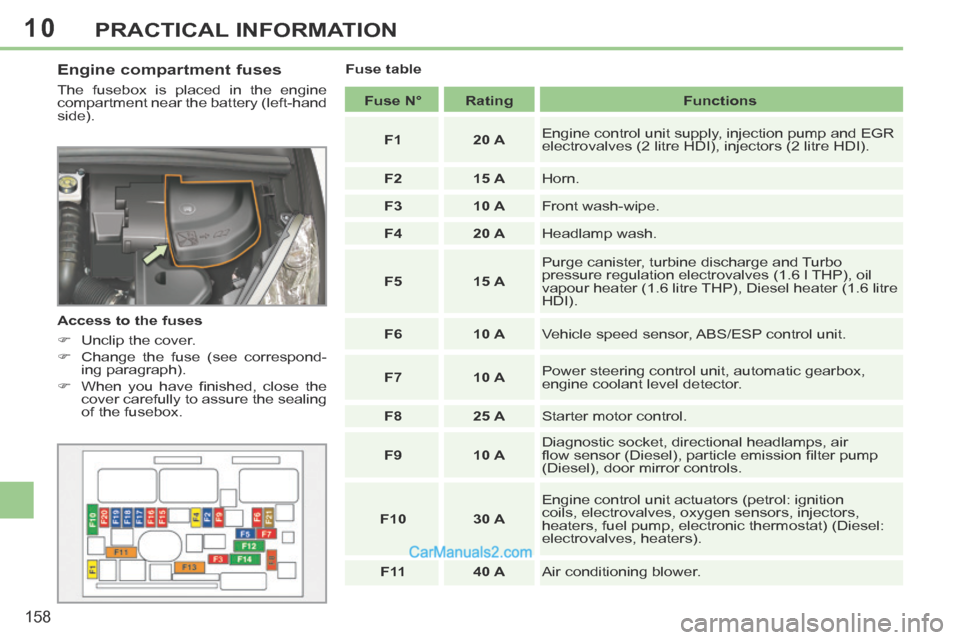Page 77 of 268

4
i
i
75
ACCESS
Quality of the fuel used for
petrol engines
The petrol engines are perfectly com-
patible with E10 or E24 type petrol
biofuels (containing 10 % or 24 % etha-
nol), conforming to European standards
EN 228 and EN 15376.
E85 type fuels (containing up to 85 %
ethanol) are reserved exclusively for ve-
hicles marketed for the use of this type
of fuel (BioFlex vehicles). The quality of
the ethanol must comply with European
standard EN 15293.
For Brazil only, special vehicles are
marketed to run on fuels containing up
to 100 % ethanol (E100 type).
Quality of the fuel used for
Diesel engines
The Diesel engines are perfectly com-
patible with biofuels which conform to
current and future European standards
(Diesel fuel which complies with stan-
dard EN 590 mixed with a biofuel which
complies with standard EN 14214)
available at the pumps (containing up
to 7 % Fatty Acid Methyl Ester).
MISFUEL PREVENTION (DIESEL) *
Mechanical device which prevents fi ll-
ing the tank of a Diesel vehicle with
petrol. It avoids the risk of engine dam-
age that can result from fi lling with the
wrong fuel.
Located in the fi ller neck, the misfuel
prevention device appears when the
fi ller cap is removed.
Operation
It remains possible to use a fuel
can to fi ll the tank.
In order to ensure a good fl ow of
fuel, do not place the nozzle of the
fuel can in direct contact with the
fl ap of the misfuel prevention de-
vice and pour slowly.
When a petrol fi ller nozzle is introduced
into the fuel fi ller neck of your Diesel
vehicle, it comes into contact with the
fl ap. The system remains closed and
prevents fi lling.
Do not persist but introduce a Diesel
type fi ller nozzle.
Travelling abroad
As Diesel fuel pump nozzles may
be different in other countries, the
presence of the misfuel prevention
device may make refuelling impos-
sible.
Before travelling abroad, we rec-
ommend that you check with the
PEUGEOT dealer network, whether
your vehicle is suitable for the fuel
pumps in the country in which you
want to travel.
The B30 biofuel can be used in cer-
tain Diesel engines; however, this use
is subject to strict application of the
special servicing conditions. Contact a
PEUGEOT dealer or a qualifi ed work-
shop.
The use of any other type of (bio)fuel
(vegetable or animal oils, pure or dilut-
ed, domestic fuel...) is strictly prohibited
(risk of damage to the engine and fuel
system).
* According to country of sale.
Page 134 of 268

9
i
132
CHECKS
RUNNING OUT OF FUEL (DIESEL)
1.6 litre HDi engine
Fill the fuel tank with at least fi ve li-tres of diesel.
Open the bonnet.
If necessary, unclip the styling cover for access to the priming pump.
Squeeze and release the priming pump repeatedly until resistance is
felt (there may be resistance at the
fi rst press).
Operate the starter until the engine starts (if the engine does not start at
the fi rst attempt, wait around 15 sec-
onds before trying again).
If the engine does not start after a few attempts, operate the priming
pump again then start the engine.
Clip the styling cover back in place.
Close the bonnet.
2 litre HDi engine
Fill the fuel tank with at least fi ve li- tres of Diesel.
Open the bonnet.
If necessary, unclip the style cover for access to the priming pump.
Squeeze and release the priming pump repeatedly until fuel appears
in the transparent pipe.
Operate the starter until the engine starts (if the engine fails to start at
the fi rst attempt, wait around 15 sec-
onds before trying again).
If the engine fails to start after a few attempts, operate the priming pump
again, then the starter.
Put the style cover back in position and clip it in place, ensuring that it
has clipped correctly.
Close the bonnet.
If the engine does not start fi rst
time, don't keep trying but start the
procedure again from the begin-
ning.
On vehicles fi tted with HDi engines, the
fuel system must be primed if you run
out of fuel; refer to the corresponding
engine compartment view.
If the tank on your vehicle is fi tted with
a misfuel prevention device, refer to the
"Misfuel prevention (Diesel)" section.
Page 136 of 268
9
134
CHECKS
DIESEL ENGINES
The various caps and covers allow ac-
cess for checking the levels of the various
fl uids, for replacing certain components
and for priming the fuel system.
1. Power steering reservoir.
2. Screenwash and headlamp wash reservoir.
3. Coolant reservoir.
4. Brake fl uid reservoir.
5. Battery / Fuses.
6. Fusebox.
7. Air fi lter.
8. Engine oil dipstick.
9. Engine oil fi ller cap.
10. Priming pump * .
* According to engine.
Page 160 of 268

10
158
PRACTICAL INFORMATION
Engine compartment fuses
The fusebox is placed in the engine
compartment near the battery (left-hand
side).
Access to the fuses
Unclip the cover.
Change the fuse (see correspond-ing paragraph).
When you have fi nished, close the cover carefully to assure the sealing
of the fusebox. Fuse table
Fuse N° Rating Functions
F1 20 A Engine control unit supply, injection pump and EGR
electrovalves (2 litre HDI), injectors (2 litre HDI).
F2 15 A Horn.
F3 10 A Front wash-wipe.
F4 20 A Headlamp wash.
F5 15 A Purge canister, turbine discharge and Turbo
pressure regulation electrovalves (1.6 l THP), oil
vapour heater (1.6 litre THP), Diesel heater (1.6 litre
HDI).
F6 10 A Vehicle speed sensor, ABS/ESP control unit.
F7 10 A Power steering control unit, automatic gearbox,
engine coolant level detector.
F8 25 A Starter motor control.
F9 10 A Diagnostic socket, directional headlamps, air
fl ow sensor (Diesel), particle emission fi lter pump
(Diesel), door mirror controls.
F10 30 A Engine control unit actuators (petrol: ignition
coils, electrovalves, oxygen sensors, injectors,
heaters, fuel pump, electronic thermostat) (Diesel:
electrovalves, heaters).
F 11 40 A Air conditioning blower.